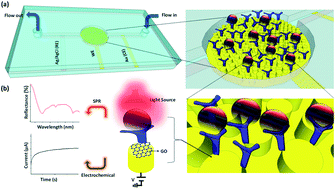Integrated dual-modality microfluidic sensor for biomarker detection using lithographic plasmonic crystal†
Abstract
This paper reports an integrated dual-modality microfluidic sensor chip, consisting of a patterned periodic array of nanoposts coated with gold (Au) and graphene oxide (GO), to detect target biomarker molecules in a limited sample volume. The device generates both electrochemical and surface plasmon resonance (SPR) signals from a single sensing area of Au–GO nanoposts. The Au–GO nanoposts are functionalized with specific receptor molecules, serving as a spatially well-defined nanostructured working electrode for electrochemical sensing, as well as a nanostructured plasmonic crystal for SPR-based sensing via the excitation of surface plasmon polaritons. High sensitivity of the electrochemical measurement originates from the presence of the nanoposts on the surface of the working electrode where radial diffusion of redox species occurs. Complementarily, the SPR detection allows convenient tracking of dynamic antigen–antibody interactions, to describe the association and dissociation phases occurring at the sensor surface. The soft-lithographically formed nanoposts provide high reproducibility of the sensor response to epidermal growth factor receptor (ErbB2) molecules even at a femtomolar level. Sensitivities of the electrochemical measurements to ErbB2 are found to be 20.47 μA μM−1 cm−2 in a range from 1 fM to 0.1 μM, and those of the SPR measurements to be 1.35 nm μM−1 in a range from 10 pM to 1 nM, and 0.80 nm μM−1 in a range from 1 nM to 0.1 μM. The integrated dual-modality sensor offers higher sensitivity (through higher surface area and diffusions from nanoposts for electrochemical measurements), as well as the dynamic measurements of antigen–antibody bindings (through the SPR measurement), while operating simultaneously in a same sensing area using the same sample volume.



 Please wait while we load your content...
Please wait while we load your content...